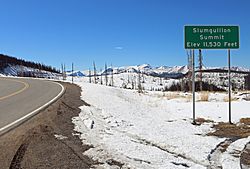Slumgullion Pass facts for kids
Quick facts for kids Slumgullion Pass |
|
|---|---|

The summit of Slumgullion Pass, looking west.
|
|
| Elevation | 11,530 ft (3,514 m) |
| Traversed by | |
| Location | Hinsdale County, Colorado |
| Range | San Juan Mountains |
| Coordinates | 37°59′08″N 107°13′20″W / 37.98556°N 107.22222°W |
| Topo map | USGS Slumgullion Pass |
Slumgullion Pass is a high mountain pass in southwestern Colorado. It sits at an elevation of 11,530 feet (3,514 meters) above sea level. This pass is part of State Highway 149, which goes east of Lake City.
The road on the north side of the pass has the steepest paved section in Colorado. It's a 9% grade, which means it's a very steep uphill climb! Even with this steep part, the pass usually stays open in winter. Snowplows work hard to clear the route regularly, making it safe for drivers. Most people find it an easy and beautiful drive, with amazing views.
You might see a road sign that says "Slumgullion Summit" instead of "Slumgullion Pass." This is because the highway was changed a long time ago. The road now takes a slightly different, higher path than the original, true Slumgullion Pass. But don't worry, everyone still calls it Slumgullion Pass!
The Slumgullion Slide: A Moving Mountain!
Slumgullion Pass gets its name from a huge landslide nearby called the Slumgullion Earthflow. Early settlers and miners thought the yellowish soil of this landslide looked like "slumgullion stew." That's how it got its unique name!
This amazing landslide started about 700 years ago. It happened when weak volcanic rock on the side of Mesa Seco slowly slid several miles down the mountain.
Then, about 300 years ago, a second part of the landslide began. This newer part is still active today! It moves as much as twenty feet (six meters) every year. If you look closely, you might see trees growing on this moving land that are tilted at strange angles. This shows how much the ground is shifting.
How the Slide Created a Lake
The first part of the Slumgullion Slide was incredibly big. It was so massive that it blocked the Lake Fork of the Gunnison River. When the river was blocked, its water began to collect.
This created Lake San Cristobal, which is now Colorado's second-largest natural lake. It's amazing to think that a slow-moving mountain of earth could create such a beautiful and important lake!


